which enables end users to play their content such as live TV, VOD, series and local audio/video files provided by them; on their Android phones, Android TVs, FireSticks and other Android devices


| Name | OTT Media Player |
|---|---|
| Publisher | mytvacces com |
| Genre | Entertainment |
| Size | 50.5MB |
| Version | 4.0.2 |
| Update | July 4, 2025 |
| Get it On | Play Store |
| Report | Report Apps |
Preview
OTT Media Player: Your Gateway to Modern Content Delivery
The entertainment landscape has transformed dramatically over the past decade. Traditional cable and satellite TV are giving way to streaming technology, and at the heart of this revolution lies the OTT media player. For content creators, broadcasters, and businesses looking to reach modern audiences, understanding OTT streaming technology has become essential for staying competitive.
This comprehensive guide explores how OTT media players work, their key benefits, essential features, and monetization strategies. Whether you’re a content creator seeking broader distribution or a business evaluating streaming solutions, you’ll discover why OTT technology represents the future of content delivery.
Understanding OTT Media Players
What is OTT?
Over-The-Top (OTT) refers to content delivery that bypasses traditional distribution methods like cable or satellite providers. Instead, OTT services deliver video, audio, and other media directly to consumers via internet connections. Popular examples include Netflix, Hulu, and Disney+.
Defining OTT Media Players
An OTT media player is a software application that enables users to stream and consume OTT content on various devices. These players serve as the bridge between content providers and end users, supporting multiple content formats including live TV, video-on-demand (VOD), series, and local audio/video files.
Modern OTT media players work across multiple platforms—Android phones, Android TVs, FireSticks, and other Android devices—making content accessible wherever audiences want to watch.
The Business Case for OTT Media Players
Significant Cost Savings
Traditional broadcasting requires substantial infrastructure investments. Television networks need expensive equipment, transmission facilities, and ongoing maintenance costs. OTT streaming eliminates many of these expenses.
Content creators can distribute their material without investing in broadcast towers, satellite uplinks, or cable infrastructure. The primary requirements are reliable internet connectivity and cloud hosting services, which cost significantly less than traditional broadcasting equipment.
Unlimited Global Reach
Geographic boundaries disappear with OTT technology. While traditional broadcasters are limited by transmission range and regional licensing agreements, OTT platforms can reach audiences worldwide instantly.
This global accessibility opens new revenue streams and audience segments previously impossible to reach. A content creator in one country can build audiences across multiple continents without additional infrastructure investments.
Personalization and Flexibility
OTT media players excel at delivering personalized experiences. Unlike traditional broadcasting’s one-size-fits-all approach, OTT platforms can customize content recommendations, viewing interfaces, and even advertising based on individual user preferences.
This personalization extends to viewing flexibility. Users can watch content on-demand, pause and resume across devices, and choose from multiple viewing options—capabilities that traditional broadcasting simply cannot match.
Essential Features of Effective OTT Media Players
Streaming Quality and Reliability
High-quality streaming forms the foundation of successful OTT platforms. Users expect smooth playback without buffering interruptions. Advanced OTT media players include:
- Adaptive bitrate streaming that adjusts video quality based on internet connection speed
- Buffer size customization allowing users to optimize performance for their network conditions
- Built-in speed test facilities to help users optimize their streaming experience
- Native and built-in player options providing backup solutions when one player encounters issues
Comprehensive Device Compatibility
Modern audiences use multiple devices throughout their day. Effective OTT media players must work seamlessly across:
- Smartphones and tablets
- Smart TVs and streaming devices
- Desktop computers and laptops
- Gaming consoles and set-top boxes
Cross-platform compatibility ensures users can start watching on one device and continue on another without losing their place or preferences.
User-Friendly Interface Design
Intuitive navigation directly impacts user satisfaction and retention. Key interface elements include:
- Clean, organized content libraries with easy browsing and discovery
- Robust search functionality helping users find specific content quickly
- Personalized recommendations based on viewing history and preferences
- Parental controls allowing families to manage content access appropriately
Advanced features like picture-in-picture mode, episode replay bars, and the ability to open channel lists directly from the video player enhance the overall user experience.
Monetization Strategies for OTT Platforms
Subscription Models
Subscription-based monetization provides predictable recurring revenue. Popular approaches include:
- Monthly or annual subscriptions offering unlimited access to content libraries
- Tiered subscription plans with different content levels and features
- Freemium models combining free content with premium paid options
Multi-screen and multi-user support allows families to share subscriptions while maintaining individual profiles and preferences.
Advertising Revenue
Ad-supported content opens OTT platforms to broader audiences while generating revenue. Effective advertising strategies include:
- Pre-roll, mid-roll, and post-roll advertisements integrated seamlessly into content
- Targeted advertising based on user demographics and viewing behavior
- Interactive advertising that engages viewers beyond passive viewing
In-App Purchases and Premium Features
Additional revenue streams come from premium features and content. Examples include:
- Premium content access for special events or exclusive releases
- Enhanced features like offline downloads, higher video quality, or advanced customization options
- Merchandise and related products promoted through the platform
Future Trends Shaping OTT Technology
Artificial Intelligence Integration
AI technology is revolutionizing content delivery through:
- Intelligent content recommendations that improve over time
- Automated content tagging and organization reducing manual management overhead
- Predictive analytics helping creators understand audience preferences and behaviors
Interactive and Engaging Content
The future of OTT streaming extends beyond passive viewing:
- Interactive storytelling where viewers influence narrative outcomes
- Real-time engagement features like live chat and social sharing
- Augmented reality elements that enhance viewing experiences
Strategic Bundling and Partnerships
OTT platforms are increasingly forming strategic alliances:
- Content bundling combining multiple services into attractive packages
- Technology partnerships integrating complementary services and features
- Distribution partnerships expanding reach through established platforms
Technical Features That Matter
Modern OTT media players include sophisticated technical capabilities:
Content Format Support: Leading platforms support multiple input methods including Xtream Codes API, URL and M3U playlists, and local audio/video files, providing flexibility for different content sources.
Enhanced Viewing Features: Advanced players offer TV catch-up broadcast capabilities, keep-watching functions, and recently added content sections that improve user engagement.
Connectivity Options: Chrome casting improvements, VPN integration, and external player support ensure users can access content through their preferred methods.
Content Management: Dynamic language changes, backup and restore settings, and parental controls give users and administrators comprehensive control over their viewing experience.
Implementing Your OTT Strategy
Successful OTT implementation requires careful planning and execution. Start by identifying your target audience and their preferred viewing habits. Research their device preferences, content consumption patterns, and willingness to pay for premium features.
Content strategy plays a crucial role in platform success. Whether you’re offering live TV, VOD, series, or local content, ensure your OTT media player supports all necessary formats and delivery methods.
Technical infrastructure deserves significant attention. Choose OTT solutions that offer robust streaming quality, comprehensive device compatibility, and the flexibility to grow with your audience.
Consider monetization strategies early in your planning process. Different audience segments respond better to specific revenue models, and your technical platform should support multiple monetization approaches.
Transform Your Content Delivery Today
OTT media players represent more than just a technology trend—they’re the foundation of modern content distribution. The combination of cost savings, global reach, personalization capabilities, and diverse monetization options makes OTT streaming an essential consideration for any content strategy.
The technical sophistication of modern OTT platforms, supporting everything from live streaming to local file playback, ensures that content creators have the tools needed to deliver professional-quality experiences across multiple devices and platforms.
Ready to revolutionize your content delivery? Explore OTT solutions today and discover how streaming technology can expand your reach, reduce your costs, and create new revenue opportunities for your content business.
Download OTT Media Player
You are now ready to download OTT Media Player for free. Here are some notes:
- Please check our installation guide.
- To check the CPU and GPU of Android device, please use CPU-Z app




























